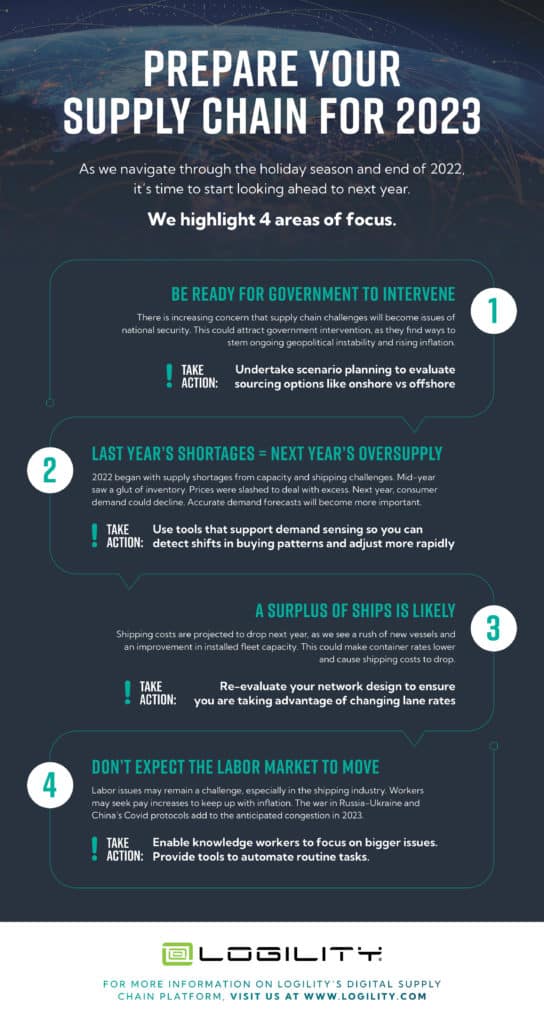
As we navigate through the end of the year and the holiday season, we’re also looking ahead to 2023. We know we’re going to see ongoing disruption. We know the chances of recession are growing. We know our clients need more and more ways to take control of their supply chain operations, end to end. Check out four of the areas we’re advising our clients to be thinking about heading into the New Year, to help prepare their supply chain for 2023.

- Governments may start to intervene1. So far, governments have left companies to manage the supply chain challenges on their own – for the most part. But there is increasing awareness and concern that supply chain challenges can be viewed as issues of national security. Some posit that governments are more likely to intervene in 2023 to address issues caused by the ongoing geopolitical events and rising inflation. We’ve already seen an example of this in late 2022, when the Biden administration acted to block the strike of thousands of railroad workers across the United States – an event that could have been catastrophic for U.S. industry and the economy. We are advising clients to:
- Utilize scenario planning in cases such as when to onshore versus offshore to evaluate sourcing options in the wake of government intervention
- Clean data and documentation to make managing government intervention easier
- Last year’s shortages = next year’s oversupply2. The beginning of the year saw us dealing with supply shortages as product was caught up in containers, as suppliers dealt with capacity challenges. Then we saw a glut of inventory hit the shelves in late summer when those bottlenecks were addressed. Retailers had to slash prices to deal with the excess. As the economy continues to head toward a recession, we expect consumer demand to decline in 2023. We’re advising clients to:
- Shift their focus to demand to avoid another oversupply situation
- Incorporate causals to ensure they are accounting for external influences to demand – accurate demand forecasts are going to play a major role in this ability
- Utilize demand sensing solutions to help detect shifts in buying patterns and rapidly adjust plans
- A surplus of ships is likely3. We expect shipping costs to drop in 2023 as we see a rush of new vessels next year. Some 28% of the current installed fleet capacity is on order; just under half of that is expected to be delivered over the course of next year. That could make container rates lower and cause shipping costs to drop. We’re advising clients to:
- Re-evaluate their network design to ensure they’re taking advantage of changing lane rates and optimal distribution network design
- Don’t expect the labor market to improve4. Labor issues raised many challenges in 2022, and the outlook remains unsteady, especially in the shipping industry, as we head into 2023. Labor actions like strikes in the U.S., U.K., Germany, South Africa, and South Korea were abundant in 2022. We expect workers to continue seeking pay increases to keep up with inflation and improved benefits overall. The Russia-Ukraine war and China’s rising Covid lockdowns add to the congestion problems in 2023.
- Start evaluating effective ways to enable your knowledge workers as you prepare your supply chain for 2023; automate routine tasks and provide decision support tools so that more time can be focused on resolving issues that matter for the business.
For other information on how to prepare your supply chain for 2023, we suggest additional reading:
Sources:
- S&P Global Market Intelligence 2022: 646180941_0822_SK_ECR_Supply-Chain-Annual-Survey_Report_SPGI_U3_LORES.pdf
Fast Company, March 2022: Supply chain issues may be here to stay after Russia’s invasion of Ukr (fastcompany.com)
Fast Company, December 2022: Why inflation is the next pandemic for supply chains
- Fast Company, May 2022: Are we or aren’t we headed for a recession? (fastcompany.com
ING, October 2022: Trade outlook 2023: slow steaming in rough waters | Article | ING Think - ING, October 2022: Trade outlook 2023: slow steaming in rough waters | Article | ING Think
- CBNC, September 2022: With new port worker strikes, Ford supply chain problems aren’t over (cnbc.com)
NY Times, September 2022: Strike Threat on Freight Railroads Is New Supply Chain Worry – The New York Times (nytimes.com)
Seafarer Worker Report, July 2021: Seafarer Workforce Report, 2021 Edition | International Chamber of Shipping (ics-shipping.org)


